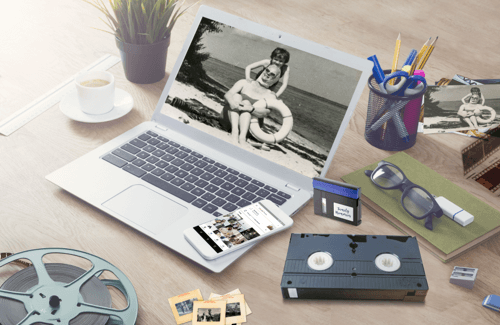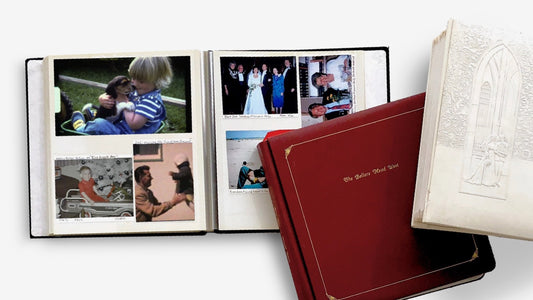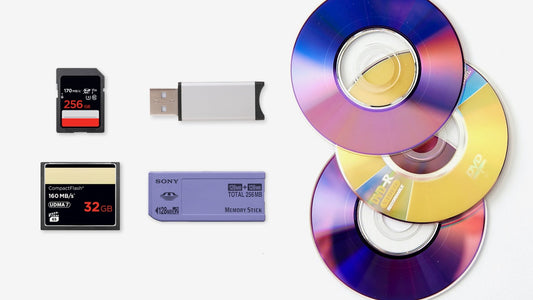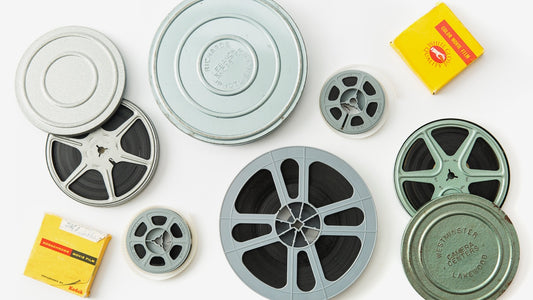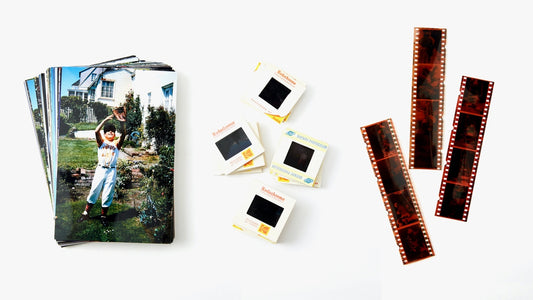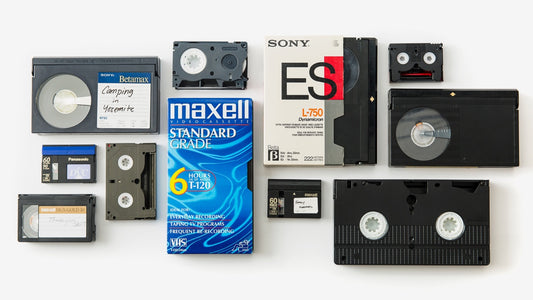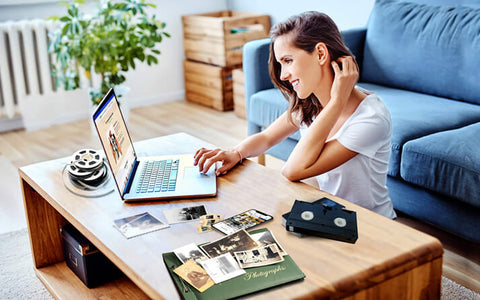Your family’s story isn’t just a collection of names and dates; it’s in the laughter, the celebrations, and the everyday moments captured on 8mm film. These reels hold the visual proof of your grandparents’ wedding dance or your dad’s first bike ride. But stuck in a box, these memories can’t be shared or relived. Digitizing them is about more than just preservation; it’s about connection. It’s about showing your kids what their grandparents looked like as young parents. This guide will show you how to transfer 8mm film to digital, turning your silent, forgotten reels into vibrant videos that can be easily shared, bringing your family’s history to life for everyone to enjoy.
Key Takeaways
- Act Now to Save Your Film: Your 8mm film reels are actively degrading, causing colors to fade and the film to become brittle. Digitizing is the only way to permanently protect these memories and make them easy to watch and share for generations.
- Weigh Your Time Against Your Budget: While a DIY transfer seems cheaper, it demands a huge time commitment and technical skill for uncertain results. Professional services offer peace of mind and a high-quality final product without the frustration.
- Prioritize Quality and Security in a Service: When going pro, look beyond the price per foot. Choose a service that offers expert color correction, handles your delicate film by hand, and provides a secure, transparent process from start to finish.
What is 8mm Film and Why Should You Digitize It?
If you’ve ever stumbled upon a box of small, mysterious film reels in a closet or attic, you’ve likely found a treasure trove of 8mm film. These reels hold priceless family moments—from birthday parties and holidays to weddings and goofy backyard antics. Before you decide what to do with them, it helps to understand what they are and why they’re so important to preserve.
What is 8mm Film?
Think of 8mm film as the original home movie format. Introduced back in the 1930s, it became incredibly popular for families and amateur filmmakers because it was affordable and much easier to handle than the bulky film used in Hollywood. The film itself is 8 millimeters wide and usually comes on small plastic reels. You might find two main types: Standard 8 and the later Super 8, which offered a slightly better picture quality. For decades, this was how families captured life in motion, creating a visual record of their history long before smartphones existed. If you have these reels, you have a direct window into the past, waiting to be reopened through film transfer.
Why Your Film Memories Are Worth Saving
Those film reels hold more than just moving pictures; they contain irreplaceable pieces of your family’s story. The problem is that physical film wasn't made to last forever. Over the years, the delicate material degrades. Colors can fade, the film can become brittle, and it can even be permanently damaged by heat, humidity, or mold. Every year that passes puts these precious memories at greater risk.
Digitizing your 8mm films is the best way to stop the clock on decay. By converting your 8mm film to digital, you create a permanent, high-quality copy that you can watch, share, and cherish for generations to come. Imagine easily sending a clip of your grandparents' wedding to your entire family or watching your dad's childhood antics on your TV. It’s about protecting your legacy and bringing it back to life.
DIY vs. Professional: Which Path is Right for You?
Deciding how to digitize your 8mm film is a big step. On one hand, you have the satisfaction and control of a DIY project. On the other, you have the ease and expertise of a professional service. There’s no single right answer—it really comes down to your budget, how much time you have, and how comfortable you are with technology. Let’s walk through the pros and cons of each approach so you can feel confident in your choice.
The DIY Route: Pros and Cons
At first glance, the DIY path seems like the most budget-friendly option. You can buy a converter, like a Kodak Reels or Wolverine device, and handle the project on your own time. However, it’s important to consider the hidden costs. These machines scan your film frame by frame, which is an incredibly time-consuming process. There’s also a learning curve to getting the settings right, and the final quality might not live up to your memories. You're essentially becoming a film technician overnight, and equipment can be finicky. Before you commit to a DIY project, weigh the value of your time against the potential savings.
Going Pro: The Benefits of a Professional Service
If the DIY route sounds like a headache, a professional service is your best bet. The biggest benefit is handing your precious memories over to experts who do this every day. They use specialized, high-end equipment that’s far more advanced than at-home converters, ensuring a high-quality digital file. This saves you an enormous amount of time and frustration. A trusted film transfer service can also offer extras like color correction and digital cleaning to make your old films look better than they have in years. While it costs more upfront, you’re paying for peace of mind and a final product you’ll be proud to share.
What to Expect for Quality
Quality can vary widely between DIY and professional methods. With a DIY converter, you’re often limited to the machine’s capabilities, which can result in lower resolution and color inaccuracies. When you go pro, you can generally expect a much better outcome. Most services deliver a standard-definition (480p) file, which is a great match for the original film’s quality. Your final videos are typically delivered on a USB, DVD, or via a digital download. Keep in mind that sound wasn't standard on 8mm film, so it's usually not included unless you have a specific format. When choosing a service, ask about their digitizing process to understand exactly what you're getting.
How to Transfer 8mm Film to Digital Yourself
If you're the hands-on type and love a good project, transferring your 8mm film at home can be a rewarding experience. It gives you complete control over the process, from the moment you clean the film reel to the final edits on your computer. For some, the satisfaction of personally handling these precious memories and seeing them come to life on a screen is part of the fun. This path isn't for everyone, though. It requires an investment in specific equipment, a good dose of patience, and a willingness to troubleshoot any issues that pop up.
Think of it as a dedicated hobby project. You'll need to set aside time not just for the scanning itself—which happens in real-time or slower—but also for preparing the film and editing the digital files afterward. The quality of the final video will depend heavily on the scanner you choose and your attention to detail. While it might seem like a way to save money, it's important to factor in the cost of the equipment and the value of your time. If you have a large collection of films, the hours can add up quickly. But if you're feeling adventurous and have just a few reels to convert, let's get into what you'll need to set up your own home film-transfer station.
Your DIY Film Transfer Toolkit
To start your DIY film transfer, you’ll need a dedicated film digitizer. These are standalone machines designed to scan your film frame by frame and save it as a digital video file, usually an MP4, onto an SD card. Popular models you might come across are the Kodak Reels or the Wolverine Reels Converter. Before you start scanning, you'll also want some basic film care supplies. This includes a soft, lint-free cloth and film cleaner to gently wipe away any dust or grime that has collected over the years. Having film splicing tape on hand is also a smart idea in case you find any broken or weak spots in your reels that need a quick repair before they can run through the machine.
A Step-by-Step Guide to Transferring Film at Home
Once your toolkit is ready, you can begin the transfer process. First, carefully clean your film reels to remove any dust. If you find any tears, repair them with splicing tape. Next, load the film onto your digitizer, making sure to follow the manufacturer's instructions for your specific model and select the correct format (8mm or Super 8). Then, start the scan. The machine will capture each frame and convert it into a video file. After the scan is complete, transfer the digital files from the SD card to your computer. From there, you can review the footage and use basic video editing software to make any desired adjustments, like trimming clips or correcting colors.
Common DIY Problems and How to Fix Them
The DIY route can come with a few hurdles. One of the biggest is inconsistent quality. Consumer-grade scanners may produce a video that looks grainy, has flickering, or shows inaccurate colors. The best fix here is patience and practice—you may need to run a few tests to get the settings right. Another common issue is the time commitment. Scanning happens in real time, so a three-minute reel takes three minutes to scan, not including setup or editing. If you have dozens of reels, this can become a massive project. While DIY seems cheaper upfront, the cost of a good scanner plus your time can add up. If you're running into quality issues or feeling overwhelmed, considering a professional film transfer can save you time and guarantee a high-quality result.
Comparing Professional 8mm Film Transfer Services
Once you decide to hand your memories over to a professional, the next step is choosing the right company. It’s a big decision—these films are irreplaceable, after all. While many services seem similar on the surface, they can differ in their process, quality, and how they handle your originals. A common misconception is that all digitization services produce the same results, but the equipment, expertise, and care taken can vary widely.
Choosing a professional service saves you time and gives you peace of mind, ensuring your home movies are preserved with the quality they deserve. To help you find the perfect fit, let's look at some of the most trusted names in the industry. Each one has a slightly different approach, so think about what matters most to you, whether it's a specific scanning resolution, a simple all-in-one kit, or the security of knowing your films are handled by hand.
YesVideo
With over 20 years of experience, YesVideo is one of the largest and most trusted names in the business. We’ve helped millions of families preserve their memories, and every single order is processed by hand at our secure facility in the USA. We understand how precious your 8mm films are, which is why our professional film transfer service focuses on both quality and care. Our team of experts handles your reels with the attention they deserve, ensuring a high-quality digital copy that your family can enjoy for generations. You get your original films back along with your new digital versions, ready to be shared.
ScanCafe
ScanCafe is another excellent option known for its commitment to quality. They are a great choice if you're looking for detailed image capture. Their service includes high-definition (HD) scans to ensure your memories are crisp and clear. A key feature is their full-frame scanning, which means none of the original picture is cropped out during the transfer process. They also perform manual color correction on a scene-by-scene basis, which can help restore the vibrancy of older, faded film. This attention to detail helps bring your home movies back to life.
Legacybox
If your attic is filled with more than just 8mm film, Legacybox might be a convenient solution. Their service is designed to be an all-in-one process for digitizing your entire family archive. You receive a box that you can fill with various media types, and they handle the rest. This is especially helpful if you also want to convert other types of old media like videotapes, photos, and audio cassettes at the same time. They send you a crush-proof box with pre-paid shipping, making the logistics simple and secure from start to finish.
Southtree
Southtree offers a very similar service to its sister company, Legacybox, but with a focus on an à la carte model. This is ideal if you know exactly what you want to convert and prefer to pay per item rather than for a pre-sized kit. They provide a straightforward process where you send in your films, and their team of technicians digitizes them by hand in their US-based studio. Like Legacybox, they emphasize safety and security, providing a reliable way to get your home movies converted into modern digital formats that are easy to watch and share with family and friends.
EverPresent
EverPresent is a great choice for those who want a more consultative and customized experience. They specialize in digitizing old films and pride themselves on high-quality results and personalized service. They offer a range of options, allowing you to choose how you receive your final digital files, which is perfect if you have specific needs for editing or archiving. With multiple locations, they also offer in-person consultations, which can be reassuring for anyone who feels nervous about shipping their one-of-a-kind memories. Their focus is on providing a premium, tailored service.
How Much Does 8mm Film Transfer Cost?
Figuring out the cost of digitizing your 8mm film is a big step in the process. The final price tag really depends on whether you decide to tackle it yourself or hand it over to the pros. Both paths have their own set of costs, and understanding them upfront will help you make the best choice for your budget and your precious memories. Let's break down what you can expect to spend.
The Cost of a DIY Project
At first glance, the DIY approach seems like the most budget-friendly option. You buy a converter, and you’re good to go, right? Not exactly. While a home film scanner is a one-time purchase, you also need to factor in other expenses. This can include cleaning supplies to prep your film, editing software to fix colors and piece clips together, and a reliable external hard drive or cloud service to store the large digital files. The biggest hidden cost, however, is your time. Learning the equipment, troubleshooting issues, and manually scanning every foot of film is a significant time investment that you should consider before you start.
What to Expect from Professional Pricing
Choosing a professional service means you're paying for expertise and peace of mind. Most services, including YesVideo, charge by the foot of film you have. For example, our film transfer service is priced at a clear per-foot rate, so you know exactly what you're paying for. This price typically includes the use of high-end, professional-grade equipment that provides a much higher quality scan than consumer devices. You’re also paying for the technician’s skill in handling delicate, old film and ensuring a smooth, flicker-free final video. Ultimately, going pro saves you countless hours and guarantees a beautiful result you can enjoy right away without any of the frustration.
Watch Out for These Hidden Costs
Whether you go DIY or pro, it’s smart to watch out for unexpected costs. With a DIY project, you might end up spending more on software or storage than you planned, or worse, invest hours only to get a poor-quality transfer. When looking at professional options, remember that not all digitization services are the same. Some companies have complicated pricing with hidden fees. Be on the lookout for extra charges like "setup fees," costs per reel, or additional payments for digital downloads on top of a DVD. A trustworthy service will be transparent about their pricing, ensuring you know the full cost before you commit to preserving your family’s history.
How to Get a High-Quality Transfer
When you decide to digitize your 8mm film, you’re not just converting it—you’re preserving it for years to come. The goal is to get a digital version that’s as clear, vibrant, and true to the original moment as possible. But what does "high-quality" actually mean in this context? It comes down to a few key technical details and a little bit of artistry. Understanding these factors will help you know what to look for, whether you’re attempting a DIY project or choosing a professional service. A great transfer captures the technical details correctly and breathes new life into the colors and clarity of your old footage, making your memories feel present again. It’s about more than just getting a file; it’s about getting the best possible version of your family’s history.
What Are Resolution and Frame Rate?
Think of resolution as the level of detail in your digital video. A higher resolution means a sharper, clearer picture. For 8mm film, you want a service that scans each tiny frame in high definition (HD) to capture all the fine details your camera originally recorded. Frame rate is just as important. It’s the speed at which the film plays, and matching it is crucial for smooth, natural-looking playback. If it’s done incorrectly, you’ll end up with jerky or fast-forwarded footage. Professional services use specialized equipment to get these settings just right, which is a big advantage over most at-home methods that can struggle to sync the frame rate correctly.
Improving Your Film with Color Correction and Restoration
Over the decades, the dyes in film can fade, leaving your memories with a blue or reddish tint. This is where color correction comes in. It’s a process that adjusts the colors to make them look vibrant and true-to-life again. But not every service handles this step the same way. The quality of color correction and restoration can vary significantly, and it’s often what separates a decent transfer from a truly amazing one. A skilled technician can also help with digital cleaning to reduce dust spots and scratches, making your memories even more enjoyable to watch. This careful restoration is a key part of a professional film transfer process that truly honors your original footage.
What About Sound?
Most 8mm and Super 8 film is silent. For most families, home movies were a purely visual experience. However, some Super 8 film came with a magnetic stripe along the edge that allowed for sound recording. If you see a thin, coppery-brown stripe on your film, you might have sound! When looking for a transfer service, it’s important to ask how they handle audio. Many services don’t transfer sound by default, and those that do may charge an extra fee. Be sure to check your reels and communicate with the company beforehand so your final digital files include both the picture and the precious, long-forgotten sounds that go with it.
What to Look for in a Film Transfer Service
Handing over your family’s one-of-a-kind film reels can feel like a leap of faith. You’re not just sending off old plastic; you’re entrusting someone with irreplaceable memories. That’s why choosing the right service is so important. Not all companies are created equal, and a little research goes a long way in ensuring your films are handled with care and converted into high-quality digital files you’ll treasure for years. To make the right choice, focus on four key areas: their technical skill, how they handle your film, the final digital files they provide, and the quality of their customer service.
Check Their Expertise and Equipment
The quality of your digital memories depends heavily on the equipment and the technicians operating it. Professional services use specialized scanners that capture your film with far more clarity and detail than any DIY setup could. Look for a company that is transparent about its process and technology. Do they have skilled technicians who can get the best results from your old film?
Beyond the initial scan, top-tier services often provide enhancements like color correction and scratch reduction. These adjustments can breathe new life into faded film, making the colors pop and restoring the picture to its original vibrancy. A company that offers a comprehensive film transfer service understands that digitization is more than just a scan—it’s an act of restoration.
How They Handle Your Precious Film
This might be the most important factor of all. How will the company treat your films once they arrive? Your reels have likely been sitting in storage for decades and are incredibly delicate. Look for a service that prioritizes the physical safety of your media. The best companies inspect and clean every reel by hand before scanning, and some even offer basic repairs for brittle splices at no extra charge.
You should also ask if they perform full-frame scanning, which ensures no part of the original image is cropped out. At YesVideo, we process every order by hand right here in the USA, because we believe your memories deserve a personal touch. You want a partner who handles your film with the same care you would, ensuring they’re returned to you in the same condition you sent them.
Your Final Files: Formats and Storage
Once your film is digitized, how will you receive it? Think about how you plan to watch, share, and store your newly preserved memories. Most services offer a few different options for your final files. You can typically choose to receive your movies on a USB drive, on DVDs, or through a secure cloud account.
A USB drive is a great physical backup that you can easily plug into a computer or smart TV. DVDs are familiar and easy to play, though they are becoming less common. A cloud-based option is fantastic for instantly sharing your films with family and friends, no matter where they are. A flexible service that offers digital media transfer in multiple formats allows you to pick what works best for your life.
Look for Great Customer Service
Sending your family history through the mail requires trust, and great customer service is key to a stress-free experience. A reliable company will keep you in the loop every step of the way. Look for services that offer order tracking and send email updates as your films move through the digitization process. This transparency provides peace of mind, so you’re never left wondering about the status of your order.
Good customer service also includes safe, trackable shipping options for both sending and receiving your films. You should feel confident that your memories are in good hands from the moment they leave your house to the moment they’re safely returned. Choosing a trusted transfer service means you’re not just paying for a product; you’re investing in a smooth and secure experience.
How to Save and Share Your Digital Memories
Once your 8mm films are digitized, the real fun begins. You’ve successfully rescued your memories from fading film reels and now have a timeless digital collection that you can enjoy for years to come. But what’s the next step? It’s all about keeping those files safe for future generations and sharing them with the people who matter most. Thinking about how you’ll store and share your new digital files is just as important as the transfer process itself, as this is how your family’s legacy will live on.
Best Ways to Store Your Digital Files
Having a solid storage plan ensures your memories are protected from being lost to a hard drive crash or accidental deletion. We recommend following the “3-2-1 backup” rule: keep at least three copies of your files, on two different types of media, with one copy stored off-site. For example, you could save your files on your computer’s hard drive, a separate external thumb drive, and a cloud storage service. Most professional services, including YesVideo, offer several options for your final files. A thumb drive is great for creating a physical backup you can tuck away safely, while our MemoryCloud access makes your videos accessible from any device, anywhere. This gives you peace of mind that your family’s history is secure.
Fun Ways to Share Your Restored Films
The best part of any video transfer is getting to relive the moments with family and friends. You can finally share that footage of your parents' wedding or your first steps with relatives across the country. Plan a family movie night and project the films onto a big screen for a nostalgic get-together. You can also create highlight reels or short clips to share on social media or in a family group chat. Because the digital files are easy to work with, you can edit them into new creations, like a montage for a milestone birthday or anniversary. These sharing ideas work just as well for old pictures, so if you have albums or slides, album scanning can help bring those memories into the digital age, consider a photo transfer to bring all your memories together.
How to Choose the Right Transfer Method for You
Deciding between a DIY project and a professional service comes down to what you value most. There’s no single right answer, but thinking through your priorities will point you in the right direction. It’s about finding the sweet spot between your budget, how much time you can spare, and the quality you expect for your irreplaceable home movies. By weighing these factors, you can confidently pick the path that best suits your family’s needs and ensures your memories are preserved just the way you want.
Consider Your Time, Budget, and Goals
At first glance, the DIY approach seems like the cheaper option. You buy a converter, and you’re ready to go. However, it’s important to think about the hidden costs. Your time is valuable, and transferring film is a slow, hands-on process that requires patience and attention to detail. Ask yourself if you have the hours to dedicate to learning the equipment, troubleshooting issues, and monitoring each transfer. If your goal is to simply get the project done reliably and without adding another task to your plate, using professional film transfer services is often the more practical choice.
Finding the Right Balance of Quality, Cost, and Convenience
When you’re dealing with one-of-a-kind memories, quality is key. A common mistake is assuming all transfer services deliver the same results. The reality is that the equipment, software, and technician expertise can vary dramatically from one company to the next. While a cheaper service might seem appealing, it could result in a lower-quality digital file that doesn’t do your original film justice. The safest and most reliable method is to use a professional service with a proven track record. Choosing an expert to digitize your 8mm films ensures you get high-quality results without the hassle and risk of a DIY project.
Related Articles
- Convert 8mm Film to Digital: The Ultimate Guide – YesVideo
- 8mm to Digital: DIY vs. Pro Services Compared – YesVideo
- Convert 8mm Film to Digital Near Me: 6 Top Services – YesVideo
- 8mm to DVD: Top Conversion Services & DIY Guide – YesVideo
- YesVideo's Film Transfer - Transfer Old Film Reels to Digital
Frequently Asked Questions
I'm not sure if I have 8mm or Super 8 film. How can I tell, and does it matter for the transfer? That's a very common question! The easiest way to tell the difference is by looking at the hole in the center of the reel. Standard 8mm film has a small hole, about the size of a pencil eraser. Super 8 film has a much larger center hole, closer to the size of a dime. While the film format does matter for the scanning equipment, you don’t need to be an expert. A professional service can easily identify and handle both types, so you can send them in without worrying about sorting them yourself.
What if my film is really old or seems damaged? Can it still be saved? It’s completely normal for decades-old film to look a little worse for wear. The material can become brittle, and the colors may have faded over time. In most cases, it can absolutely be saved. Professional technicians are trained to handle delicate film with care. They inspect each reel by hand, clean off dust and debris, and can often repair old, weak splices to ensure the film runs smoothly through the scanner. While some damage can’t be reversed, you’d be surprised how much life can be brought back to even the oldest reels.
How long does a professional transfer service usually take? The turnaround time for a professional service depends on the size of your order and the company's current volume, but you can generally expect the process to take a few weeks from the time they receive your films. The best services provide order tracking and send you email updates at each stage, from when your box arrives at their facility to when your originals and new digital copies are shipped back to you. This way, you always know exactly where your precious memories are in the process.
Will I get my original film reels back after they are digitized? Yes, absolutely. The goal of a transfer service is to create a high-quality digital copy of your memories, not to replace your originals. Any reputable company will handle your films with great care and return them to you along with your new digital files, whether they're on a USB, DVDs, or in the cloud. You should receive everything back in one secure shipment.
What's the best way to watch the digital files once I get them? This is the best part! Once your films are digitized, they are incredibly easy to enjoy. If you choose to receive your files on a USB drive, you can simply plug it into the USB port on your smart TV or computer to watch them instantly. If you opt for a digital download or cloud access, you can stream them on any device and easily share links with family and friends, no matter where they live. It’s all about making your memories accessible again.




